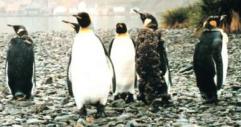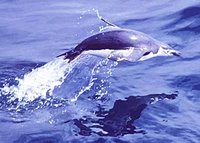Penguin
|
|
- This article is about penguin birds. For other meanings, see Penguin (disambiguation).
| Penguins | ||||||||||
|---|---|---|---|---|---|---|---|---|---|---|
 | ||||||||||
| Scientific classification | ||||||||||
| ||||||||||
| Genera | ||||||||||
|
Aptenodytes |
Penguins (order Sphenisciformes, family Spheniscidae) are an order of flightless birds living in the southern hemisphere. They are not, contrary to popular belief, only found in cold climates, such as Antarctica. Three species live in the tropics; one lives as far north as the Galapagos Islands and will occasionally cross the equator while feeding. Actually, most penguins do not live in Antarctica; only a few species do. The others live further north.
Penguins like to stay and move within large groups. Most penguins live off krill, fish, squid, and other forms of sealife that they catch while swimming underwater. They spend half of their life time on land and half in the oceans.
The largest species is the Emperor Penguin (Aptenodytes forsteri): adults average about 1.1 meters (3-4 feet) tall and weigh 35 kilograms (75 lb) or more. The smallest penguin species is the Little Blue Penguin (also known as the Fairy Penguin), which stands around 25 cm tall (14-16 in.) and weighs 1 kilogram (2.5 lb). Generally larger penguins retain heat better and thus inhabit colder regions, while smaller penguins are found in temperate or even tropical climates.
Penguins emerged in the Eocene era 40 million years ago. Birds like Palaeeudyptes from the Eocene, Pachydyptes from the Miocene and the now extinct Great Auks resembled modern penguins. The links between other bird orders and penguins are still unknown, and though a close relationship between penguins, Procellariiformes and Gaviiformes is usually assumed, it has not been proved and some anatomical evidence has been interpreted as supporting a placement of Spheniscidae within a group of birds classified as Pelecaniformes. Most fossil penguins known are large, but not larger than the modern Emperor Penguin. All lived in the southern hemisphere.
| Contents |
Anatomy
Penguins are superbly adapted to an aquatic life. Their wings have become flippers, useless for flight in the air. In the water, however, penguins are astonishingly agile. Within the smooth plumage a layer of air is preserved, ensuring buoyancy. The air layer also helps insulate the bird in the icy waters of the Antarctic. The plumage of penguins in tropical and temperate zones is much thinner.
On land, penguins use their tails and wings to maintain balance.
All penguins have a white underside and a dark (mostly black) upperside. This is for camouflage. A predator looking up from below (such as an orca or a leopard seal) has difficulty distinguishing between a white penguin belly and the reflective water surface.
Diving penguins reach 6 to 12 km/h, though there are reports of velocities of 27 km/h (which are probably realistic in the case of startled flight). The small penguins do not usually dive deep; they catch their prey near the surface in dives that normally last only one or two minutes. Larger penguins can dive deep in case of need. The Emperor Penguin has been recorded reaching a depth of 875 feet (270 metres) and staying submerged for 18 minutes.
On land, penguins are clumsy. They either waddle on their feet or slide on their bellies across the snow, a movement called "tobogganing", which allows them to conserve energy and move relatively fast at the same time.
Penguins have an excellent sense of hearing. Their eyes are adapted for underwater vision, and are their primary means of locating prey and avoiding predators; in air, conversely, they are nearsighted. Their sense of smell has not been researched so far.
Penguins have no external genitalia. Consequently, chromosome testing must be done in order to determine a penguin's sex.
Sexuality and mating habits
Penguins mate for life. They generally raise a small brood, and the parents co-operate in caring for the clutch and for the young.
Gay_penguins_NY_Zoo.jpg
Male chinstrap penguins, one of several homosexual pairs at the Central Park Zoo in Manhattan.
(Picture:Nicole Bengiveno/The New York Times)
Male penguin couples have been also been documented. They too mate for life and build nests together. Male couples have been recorded using a stone to replace sitting on an egg in the nest. In 2004, the Central Park Zoo in the United States replaced one male couple's stone with a fertile egg which they then raised as their own offspring [1] (http://www.sfgate.com/cgi-bin/article.cgi?f=/c/a/2004/02/07/MNG3N4RAV41.DTL). Homosexuality among penguins has also been reported by a German zoo and Kelly Tarlton's Aquarium in Auckland New Zealand. [2] (http://www.chorley-pct.nhs.uk/documents/projoscaug04news.pdf)
Classification
HumboldtPenguinAndEggs.jpg
ORDER SPHENISCIFORMES
- Family Spheniscidae
- King Penguin, Aptenodytes patagonicus
- Emperor Penguin, Aptenodytes forsteri
- Gentoo Penguin, Pygoscelis papua
- Adelie Penguin, Pygoscelis adeliae
- Chinstrap Penguin, Pygoscelis antarctica
- Rockhopper Penguin, Eudyptes chrysocome
- Fiordland Penguin, Eudyptes pachyrhynchus
- Snares Penguin, Eudyptes robustus
- Royal Penguin, Eudyptes schlegeli
- Erect-crested Penguin, Eudyptes sclateri
- Macaroni Penguin, Eudyptes chrysolophus
- Yellow-eyed Penguin, Megadyptes antipodes
- Little Penguin (or Fairy Penguin), Eudyptula minor
- White-Flippered Penguin, Eudyptula albosignata
- African Penguin, Spheniscus demersus
- Magellanic Penguin, Spheniscus magellanicus
- Humboldt Penguin, Spheniscus humboldti
- Galapagos Penguin, Spheniscus mendiculus
Name
Penguin2.jpg
Penguin is thought by some to derive from the Welsh words pen (head) and gwyn (white), applied to the Great Auk, which had a conspicuous white patch between the bill and the eye (although its head was black), or from an island off Newfoundland known as "White Head" due to a large white rock. According to another theory, the original name was pen-wing, with reference to the rudimentary wings of both Great Auks and penguins. A third theory is that penguin comes from the Latin pinguis (fat).
Penguins in popular culture
Penguins are popular around the world owing to their harmless nature, their upright stance for standing and walking, which humans find charming or comical, and their striking black and white plumage that is often humorously likened to a tuxedo suit.
Magellanic-penguin02.jpg

